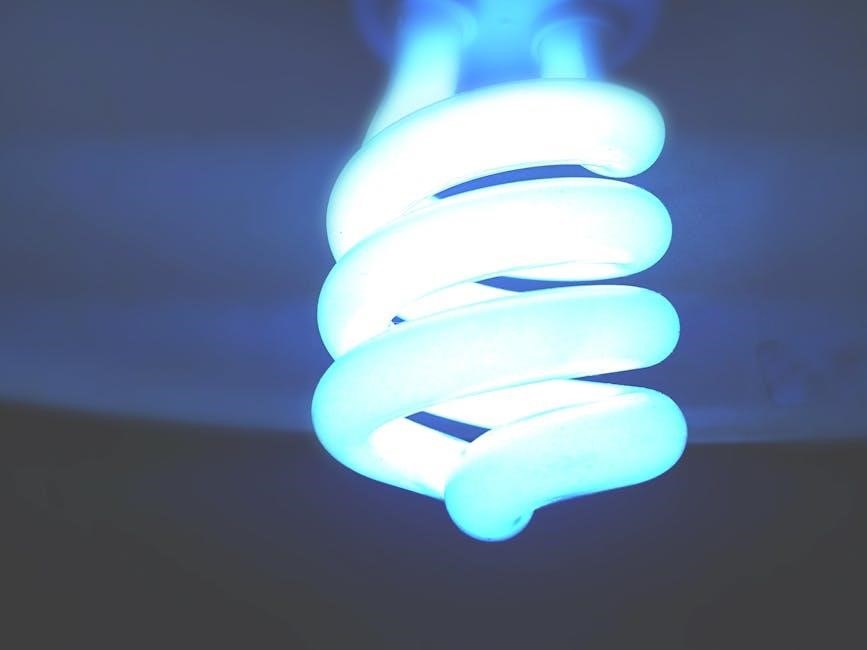Light bulb temperature, measured in Kelvin, influences color quality, energy efficiency, and heat emission. Understanding it helps choose the right lighting for various spaces and needs effectively.
1.1 Understanding Color Temperature and Its Importance
Color temperature, measured in Kelvin (K), defines the light’s hue, ranging from warm white (2700K-3000K) to cool white (3500K-5000K). It impacts ambiance, task performance, and visual comfort. Warm tones create cozy, relaxing environments, while cool tones enhance focus and brightness. Understanding this helps in selecting bulbs that align with space aesthetics and functional needs, ensuring optimal lighting for various settings, from homes to workplaces. Proper color temperature selection balances aesthetics and functionality, making it crucial for effective lighting design and user satisfaction.
Color Temperature Basics
Color temperature describes the light’s color, from warm to cool tones, measured in Kelvin. It affects the ambiance and suitability for different tasks and environments.
2.1 Kelvin Scale: From Warm White to Cool White
The Kelvin scale measures light bulb color temperature, ranging from warm white (2700K-3000K) to cool white (3500K-5000K) and daylight (5000K-6500K). Lower Kelvin values produce warmer, yellower tones, often used in residential settings for a cozy ambiance. Higher Kelvin values emit cooler, bluer light, ideal for task-oriented spaces like kitchens or offices. Understanding this range helps in selecting the appropriate lighting to enhance both functionality and aesthetics in various environments, ensuring the right mood and visibility are achieved.
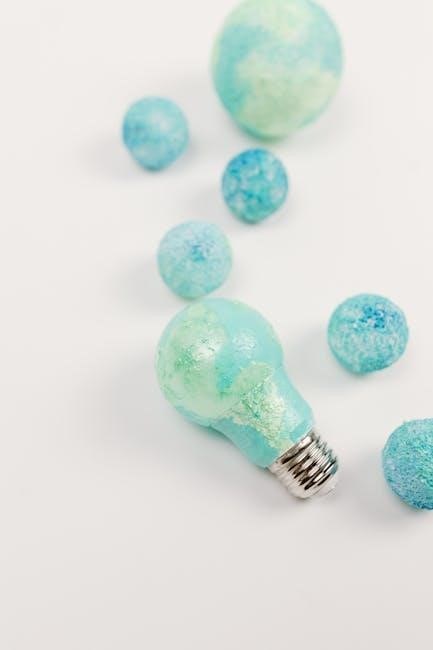
Types of Light Bulbs and Their Temperature Ratings
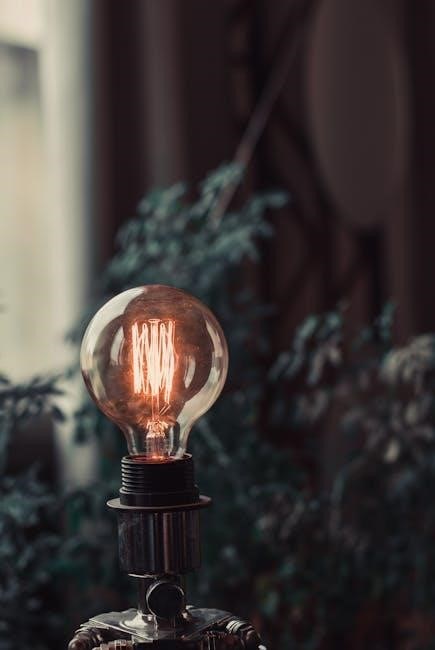
LED, incandescent, and halogen bulbs vary in temperature ratings, with LED offering precise control, incandescent producing warm tones, and halogen providing bright, cooler light options.
3.1 LED Bulbs: Energy Efficiency and Temperature Control
LED bulbs excel in energy efficiency, converting most of their energy to light rather than heat. They offer precise temperature control, ranging from warm to cool tones, enhancing ambiance and functionality without excessive heat emission.

3.2 Incandescent Bulbs: Heat Production and Color Temperature

Incandescent bulbs produce heat as a byproduct of generating light, with only a fraction of energy used for illumination. Their color temperature varies, offering warm tones, but their inefficiency and heat output make them less ideal for modern lighting needs.
3.3 Halogen Bulbs: Brightness and Temperature Characteristics
Halogen bulbs are known for their high brightness and warm color tones, typically ranging from 2800K to 3200K. They maintain consistent light output over time and are often used in task lighting. Despite their efficiency compared to traditional incandescent bulbs, halogen bulbs still emit significant heat. Their compact design makes them ideal for directional lighting fixtures. However, they are less energy-efficient than LED bulbs and may require careful handling due to their high operating temperatures. They are suitable for applications where bright, focused light is essential.
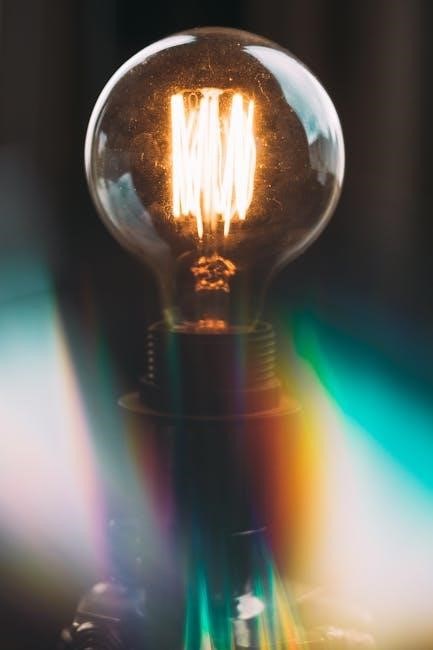
How Light Bulb Temperature Affects Room Temperature
Light bulb temperature impacts room climate through heat emission. Higher wattage bulbs produce more heat, potentially raising room temperature, especially in enclosed or poorly ventilated spaces over time.
4.1 Heat Emission and Its Impact on Room Climate
Light bulbs emit heat, which can influence room temperature, especially in poorly ventilated areas. Incandescent bulbs produce significant heat, while LEDs emit minimal heat due to their energy efficiency. The heat output varies by wattage and bulb type, with higher wattage bulbs contributing more to room warming. For example, a 70-watt bulb can slightly increase a room’s temperature over time; This effect is more noticeable in smaller, enclosed spaces. Managing bulb selection and ventilation can help maintain a comfortable room climate while optimizing lighting needs.
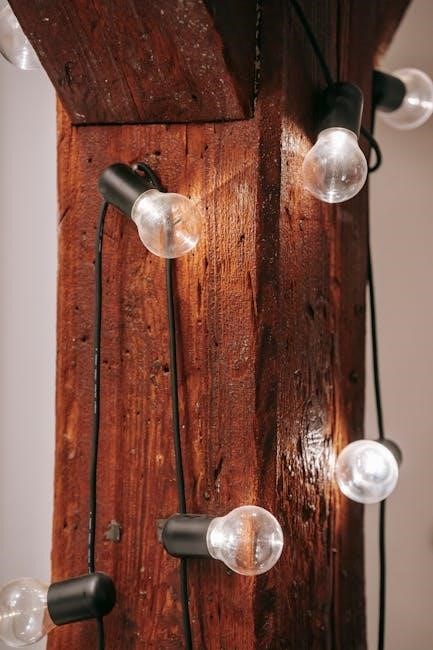
Color Rendering Index (CRI) and Temperature
CRI measures how well a light bulb reproduces colors. Higher CRI values indicate better color accuracy. Combined with temperature, it determines the light’s quality and suitability for spaces.
5.1 Understanding CRI and Its Relation to Light Quality
CRI measures a bulb’s ability to display colors accurately, rated 0-100. Higher CRI enhances color clarity, crucial for tasks requiring precision. Kelvin temperature complements CRI, balancing warmth and brightness. Together, they determine the quality of light, impacting aesthetics and functionality. Proper CRI and temperature selection ensure optimal lighting for any environment, making spaces more inviting and functional. This combination is vital for both residential and commercial settings, where light quality significantly affects comfort and productivity. Thus, understanding CRI and temperature is essential for choosing the right bulbs.
Choosing the Right Bulb for Different Spaces
Selecting the right bulb depends on space type and purpose. Residential spaces often use warm tones for comfort, while commercial areas prefer brighter, cooler options. Outdoor lighting requires durability and weather resistance to ensure safety and longevity. Proper bulb selection enhances functionality, aesthetics, and energy efficiency, making it essential to consider specific needs for each area. This ensures optimal lighting that meets both practical and ambient requirements effectively. Understanding these factors helps in making informed decisions for various environments and applications. Always consider the intended use and environment when choosing bulbs.
6.1 Residential Lighting: Warm to Neutral Color Temperatures
Residential lighting often favors warm to neutral tones, typically between 2700K-3500K. These temperatures create a cozy, inviting atmosphere ideal for living rooms and bedrooms. Soft White LED bulbs are recommended for their warm glow, resembling traditional incandescent lights. Neutral tones, around 3000K-3500K, offer a balanced ambiance suitable for kitchens and dining areas. Bright White options, near 3500K, provide slightly cooler tones that enhance task lighting. Choosing the right color temperature ensures comfort and functionality, making spaces feel welcoming and well-lit without harshness. This range is versatile, catering to diverse decor and personal preferences effectively. Always consider the room’s purpose when selecting.
6.2 Commercial Lighting: Cool and Bright Options
Commercial lighting typically uses cool, bright tones between 3500K-5000K to enhance focus and productivity. These temperatures provide crisp, energizing light ideal for offices, retail spaces, and hospitals. Cool white bulbs, around 4100K, are common in task-oriented areas, while daylight bulbs (5000K) mimic natural light, reducing eye strain. LED options dominate due to their energy efficiency and longevity. They emit minimal heat, making them ideal for continuous use. Choosing the right cool tone ensures a professional, functional environment that supports efficiency and comfort without sacrificing light quality. This range is essential for spaces requiring clarity and alertness. Always opt for high CRI for better color accuracy.
6.3 Outdoor Lighting: Durable and Weather-Resistant Solutions
Outdoor lighting requires durability and weather resistance to withstand harsh conditions. LED bulbs are ideal, offering energy efficiency and long lifespan. Cool tones (4000K-5000K) provide bright, clear light for security and visibility. Look for moisture-resistant and vandal-proof options. Durable materials like stainless steel or polycarbonate ensure longevity. Motion sensors enhance functionality. These solutions are designed to endure extreme temperatures and weather, ensuring reliable performance. Always choose bulbs with high IP ratings for optimal protection against dust and water. This ensures your outdoor spaces remain well-lit and safe year-round.
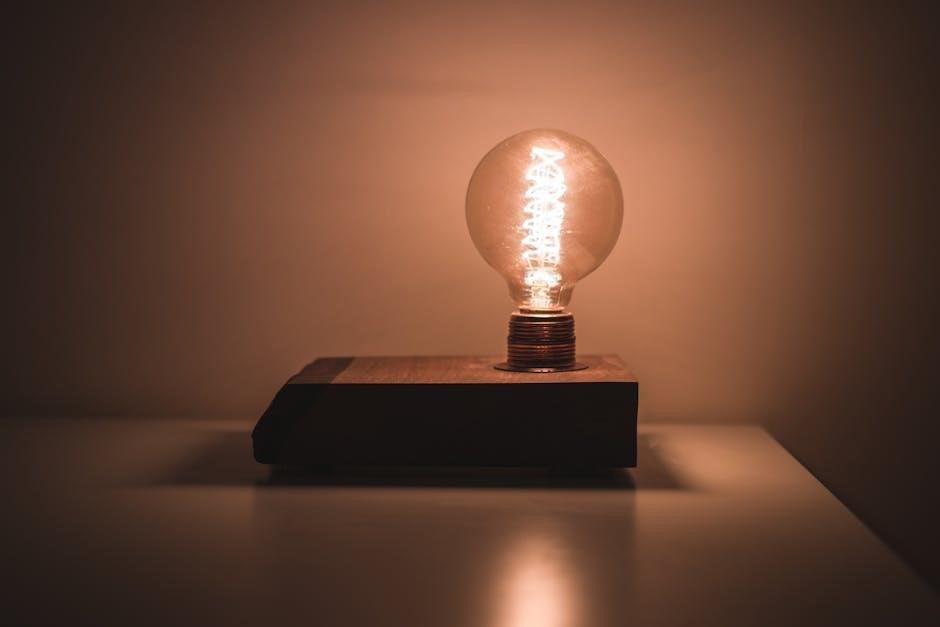
Energy Efficiency and Temperature
Energy-efficient bulbs, like LEDs, emit less heat while maintaining brightness, reducing energy consumption and lasting longer than traditional options.

7.1 LED Bulbs: Lower Heat, Higher Efficiency
LED bulbs are renowned for their exceptional energy efficiency and minimal heat emission. Unlike incandescent bulbs, LEDs convert a higher percentage of electricity into visible light rather than heat, significantly reducing energy waste. This makes them more environmentally friendly and cost-effective in the long run. Additionally, their longer lifespan lowers maintenance costs, as they need to be replaced less frequently. The lower heat output also enhances safety, reducing the risk of burns or fires. Overall, LEDs offer a cooler, brighter, and more efficient lighting solution compared to traditional options.
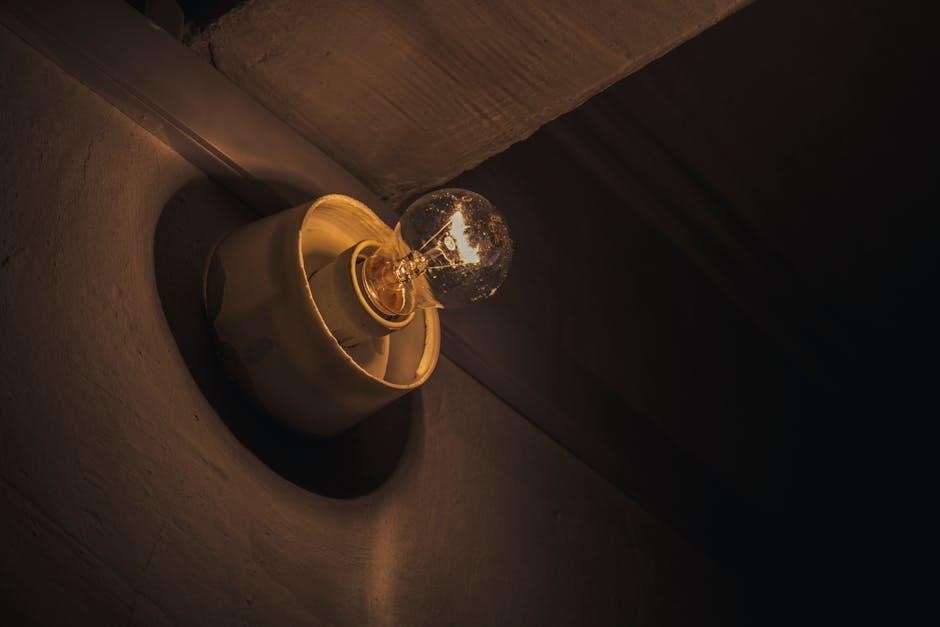
Safety Considerations
Handling light bulbs requires care to avoid breaks and potential exposure to hazardous materials like mercury in fluorescent bulbs. Proper disposal is essential to prevent environmental contamination.
8.1 Mercury in Fluorescent Bulbs and Disposal Tips
Fluorescent bulbs contain small amounts of mercury, a toxic substance. Proper disposal is crucial to prevent environmental contamination. Recycling facilities safely handle these bulbs, breaking them down to recover mercury and other materials. Homeowners should avoid breaking bulbs, as mercury vapors can release, posing health risks. When handling, use gloves and promptly clean up breaks with a damp cloth, sealing fragments in airtight containers. Check local guidelines for disposal options, ensuring responsible management of mercury-containing lighting products.
Future Trends in Lighting Technology
Advancements in smart lighting and color-tunable bulbs are revolutionizing the industry. High-efficiency LEDs, voice-controlled systems, and integration with smart home devices are expected to dominate future trends.
9.1 Smart Lighting and Color-Tunable Bulbs
Smart lighting systems integrate seamlessly with smart home devices, enabling voice-controlled adjustments. Color-tunable bulbs allow users to customize brightness and color temperature, enhancing ambiance and functionality. Energy-efficient LEDs dominate this space, offering long-term savings and convenience. These innovations redefine lighting, making it adaptable to various needs and preferences, while improving overall energy efficiency and user experience.
